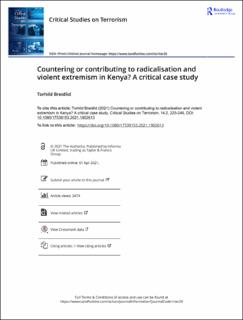| dc.contributor.author | Breidlid, Torhild | |
| dc.coverage.spatial | Kenya | en_US |
| dc.date.accessioned | 2022-07-08T13:37:14Z | |
| dc.date.available | 2022-07-08T13:37:14Z | |
| dc.date.created | 2021-05-15T19:07:22Z | |
| dc.date.issued | 2021-07-01 | |
| dc.identifier.citation | Critical Studies on Terrorism. 2021, 14 (2), 225-246. | en_US |
| dc.identifier.issn | 1753-9153 | |
| dc.identifier.issn | 1753-9161 | |
| dc.identifier.uri | https://hdl.handle.net/11250/3003888 | |
| dc.description.abstract | In this article, I argue that the “theological and social-psychological radicalisation model”, which has been primarily used in a Western context, has influenced the strategies used by the Kenyan government to explain and combat radicalisation and terrorism. The model predominantly focuses on religion and social networks as crucial to the radicalisation process. My research in Kenya demonstrates how the underlying principles of the model are used in a non-Western context. I claim that the Kenyan government is increasingly using the model to delegate surveillance, especially to the security sector but also to some civil society actors. As illustrated in my findings, Kenya has, through specific definitions, reports and statements, contributed to the institutionalisation of the term radicalisation and its link to Islam. My argument is substantiated by an analysis of official policy documents, official statements and interviews. Paradoxically, the hard approach taken by the security sector in Kenya towards the Muslim population seems to have further fuelled radicalisation in the country. | en_US |
| dc.language.iso | eng | en_US |
| dc.publisher | Routledge | en_US |
| dc.relation.ispartofseries | Critical Studies on Terrorism;Volume 14, 2021 - Issue 2 | |
| dc.rights | Attribution-NonCommercial-NoDerivatives 4.0 Internasjonal | * |
| dc.rights.uri | http://creativecommons.org/licenses/by-nc-nd/4.0/deed.no | * |
| dc.subject | Radicalisation models | en_US |
| dc.subject | Suspect communities | en_US |
| dc.subject | Aarhus model | en_US |
| dc.subject | Critical terrorism studies | en_US |
| dc.subject | Orientalism | en_US |
| dc.subject | Indicators of terrorist risks | en_US |
| dc.title | Countering or contributing to radicalisation and violent extremism in Kenya? A critical case study | en_US |
| dc.type | Peer reviewed | en_US |
| dc.type | Journal article | en_US |
| dc.description.version | publishedVersion | en_US |
| dc.rights.holder | © 2021 The Author(s) | en_US |
| cristin.ispublished | true | |
| cristin.fulltext | original | |
| cristin.qualitycode | 1 | |
| dc.identifier.doi | https://doi.org/10.1080/17539153.2021.1902613 | |
| dc.identifier.cristin | 1910182 | |
| dc.source.journal | Critical Studies on Terrorism | en_US |
| dc.source.volume | 14 | en_US |
| dc.source.issue | 2 | en_US |
| dc.source.pagenumber | 225-246 | en_US |

